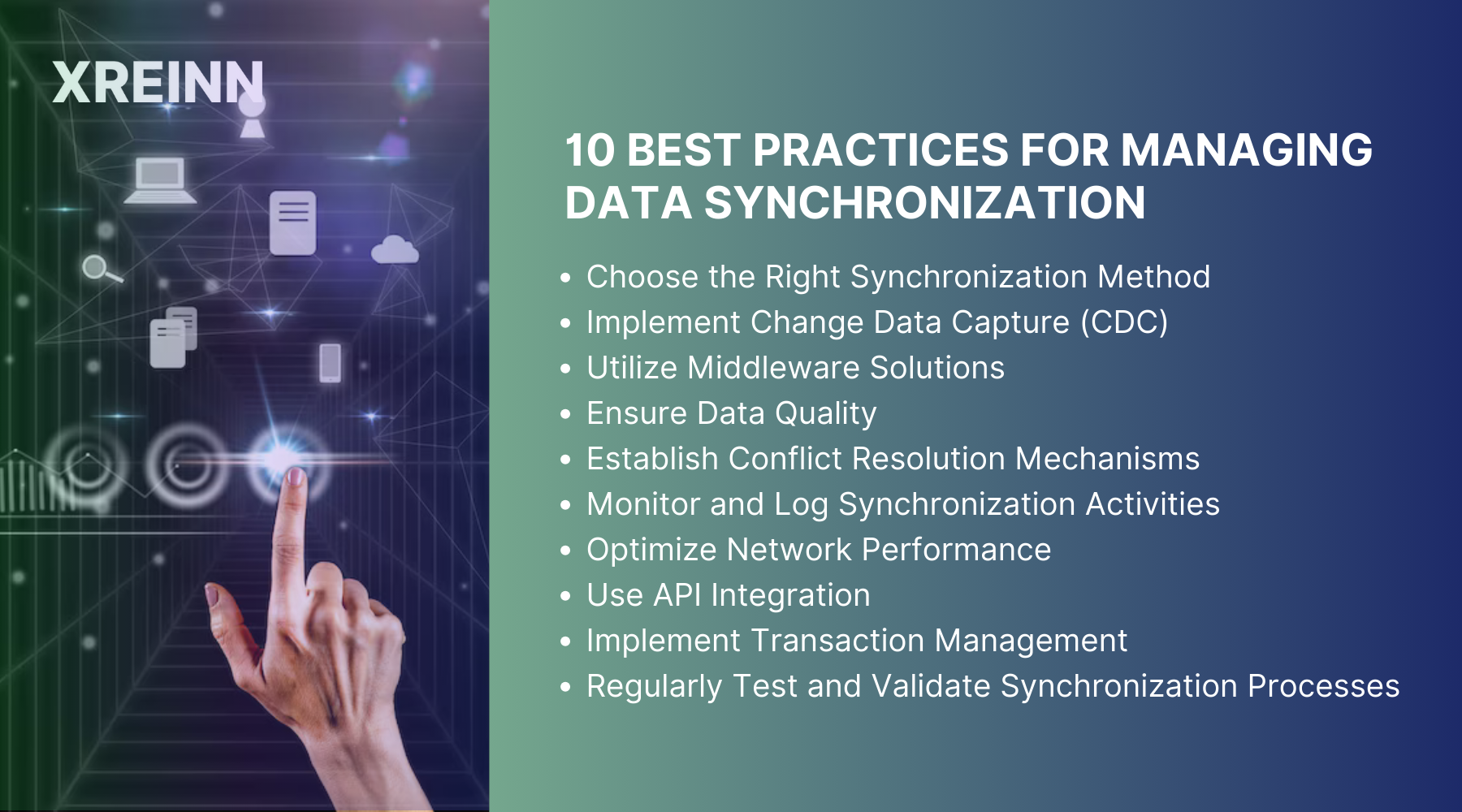Data Integration
10 Best Practices for Managing Data Synchronization
Jul 23, 2024
Have you ever found yourself caught in the complex web of data synchronization? It's a challenging task, even for professionals. Without proper synchronization, businesses face challenges like data inconsistencies, operational inefficiencies, and decision-making errors. These issues can lead to missed opportunities, customer dissatisfaction, and increased costs. Ensuring data stays in sync across systems is important to maintaining accuracy and reliability.
Let’s explore the advanced strategies for managing data synchronization effectively. If you’re looking to improve your skills and achieve seamless data integration, you’re in the right place.
What is Data Synchronization?
Data synchronization is the process of ensuring that data across multiple systems or databases remains consistent and up-to-date. When data changes in one system, synchronization ensures those changes are reflected in other connected systems. This is important for maintaining data integrity and accuracy across various platforms, whether it's between different applications, databases, or cloud services.
For example, when a customer updates their contact information in a CRM system, synchronization ensures that the same information is updated in the billing and support systems. This seamless flow of data helps avoid inconsistencies, supports real-time operations, and enhances overall efficiency.
Importance of Data Synchronization
Data synchronization is important for ensuring that information remains consistent and accurate across multiple systems. Imagine your business relies on different platforms for operations such as sales, inventory, and customer relations. Without proper synchronization, a sale recorded in your CRM might not immediately update your inventory system, leading to stock inconsistencies and potential losses. Consistent data across systems improves decision-making by providing reliable and up-to-date information. It supports real-time operations, minimizes errors, and reduces data duplication.
Additionally, synchronized data improves customer satisfaction by ensuring that all departments have access to the same accurate information, leading to more efficient and effective service. Ultimately, data synchronization is essential for maintaining operational efficiency, accuracy, and reliability in any business environment.
10 Best Practices for Managing Data Synchronization

Here are the best practices for managing data synchronization.
1. Choose the Right Synchronization Method
Selecting the appropriate synchronization method is fundamental. You have options like one-way, two-way, and multi-way synchronization. One-way synchronization updates data in one direction, suitable for backup and reporting purposes. Two-way synchronization, on the other hand, keeps data consistent in both directions, ideal for systems that need to share and update information reciprocally. Multi-way synchronization is used when multiple systems need to stay in sync simultaneously. Assess your needs and choose the method that best fits your data flow requirements.
2. Implement Change Data Capture (CDC)
Change Data Capture (CDC) is a technique that identifies and captures changes made to the data in real time. By implementing CDC, you ensure that only the changed data is synchronized, reducing the load on your systems and improving efficiency.
Tools like Debezium and Oracle GoldenGate can help in capturing these changes effectively. This method not only improves performance but also ensures that no changes are missed during synchronization.
3. Use Middleware Solutions
Middleware acts as a bridge between different systems, facilitating data transfer and synchronization. Using middleware solutions like Apache Kafka or RabbitMQ can streamline your data synchronization process. These tools provide strong messaging and streaming capabilities, ensuring that data flows seamlessly between systems. Middleware also offers scalability, allowing you to handle increasing data volumes without compromising performance.
4. Ensure Data Quality
High-quality data is a prerequisite for effective synchronization. Implement data validation checks and cleansing processes to ensure that the data being synchronized is accurate and reliable. Tools like Talend andInformatica can help maintain data quality by detecting and correcting errors, duplicates, and inconsistencies. Remember, synchronizing poor-quality data can lead to bigger issues down the line.
5. Establish Conflict Resolution Mechanisms
Data conflicts are inevitable, especially in two-way or multi-way synchronization. Establish strong conflict resolution mechanisms to handle discrepancies. Define clear rules and priorities for which data source should take precedence in case of conflicts. Implement automated conflict resolution where possible, but also provide manual review options for critical data. This ensures that conflicts are resolved efficiently without compromising data integrity.
6. Monitor and Log Synchronization Activities
Continuous monitoring and logging of synchronization activities are crucial for maintaining system health. Implement comprehensive logging to track synchronization processes, identify obstacles, and troubleshoot issues. Tools like Elasticsearch and Kibana can help you visualize logs and monitor synchronization performance in real time. Regular monitoring allows you to proactively address problems and ensure smooth data flow.
7. Optimize Network Performance
Data synchronization often involves transferring large volumes of data over the network. Optimize your network performance to minimize delay and ensure fast data transfer. Use techniques like data compression, caching, and load balancing to enhance network efficiency.
Additionally, consider implementing a content delivery network (CDN) if you’re dealing with geographically distributed systems to reduce data transfer times.
8. Use API Integration
APIs are powerful tools for data synchronization. By using APIs, you can facilitate real-time data exchange between different systems. Ensure that your APIs are well-documented, secure, and capable of handling high volumes of data. Use RESTful APIs for flexibility and ease of integration, or consider GraphQL for more efficient querying and data retrieval. APIs provide a standardized way to connect systems and synchronize data seamlessly.
9. Implement Transaction Management
Transaction management ensures that all data changes are synchronized consistently and reliably. Use techniques like or distributed transactions to ensure atomicity and consistency across multiple systems. These techniques help in maintaining data integrity even in the event of failures or interruptions during synchronization. Implementing robust transaction management is essential for ensuring that your data synchronization process is reliable and fault-tolerant.
10. Regularly Test and Validate Synchronization Processes
Finally, regularly test and validate your synchronization processes to ensure they are working as intended. Conduct end-to-end testing to identify and address any issues or gaps in your synchronization setup. Use test automation tools to simulate different scenarios and validate data consistency. Regular testing helps in maintaining the reliability of your synchronization processes and ensures that your systems remain in sync at all times.
Conclusion
Effective data synchronization is important for maintaining data consistency and operational efficiency in today’s interconnected world. By adopting these advanced practices, you can ensure seamless data flow, minimize conflicts, and enhance overall system performance.
Remember, the key lies in choosing the right synchronization methods, implementing strong conflict resolution mechanisms, and continuously monitoring and optimizing your processes. Use the above strategies, and you’ll be well-equipped to handle the complexities of data synchronization with confidence

Data Analytics
Jun 27, 2024Master key concepts in data analytics with practical tips to enhance decision-making and achieve success in your projects and professional growth

Data Analytics
Jul 01, 2024Learn the essential stages of the data analytics workflow to turn your data into valuable business insights and drive growth.

